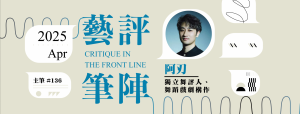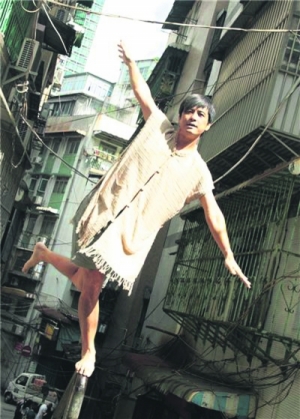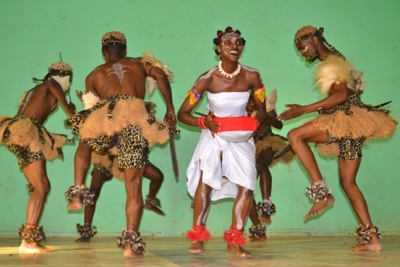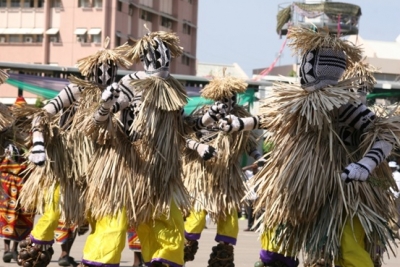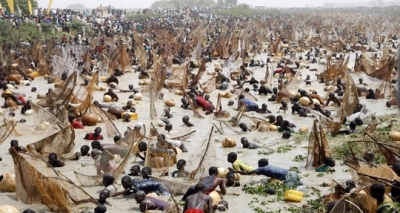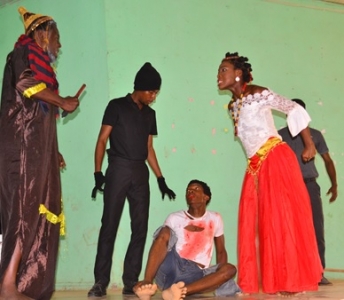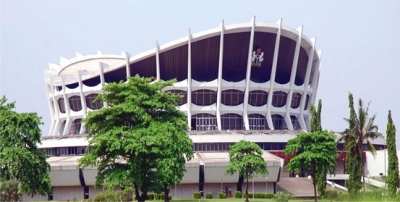2017年3月
The question of identity became dominant in African theatre at the onset of colonialism. The colonial masters imported into Africa their kind of theatre, which was in many respects different from the type that existed in pre-colonial African societies. As is to be expected, consequent upon the interaction between the two cultures, there now exist syncretic forms of entertainment, which are a fusion of the two theatre traditions. Since the early 1960s, African scholars and theatre critics in particular have sustained the conversation on what features define an authentic African theatre. Today this conversation is still raging because of the twin burdens of globalization and colonialism. In most African cities, foreign entertainment forms still exist side by side the indigenous African performances. At the level of theory, both the African and European theatre traditions have their distinct aesthetic canons. Negotiating these canons is part of what makes the task of the theatre critic in Africa engaging but tricky. This paper examines the challenge of negotiating cultural identity through theatre, performance and criticism in Africa.
The theatre critic in traditional African society exists more as a performer than a literary artist. He is either embodied in the highly participatory African theatre audience or exists as that virtuoso multi-talented performer who understands his people’s artistic tastes, values, social mores and culture. Like the modern theatre critic, he is one who can evaluate a creative work and make an informed statement on its artistic merits or otherwise. He is not just a performer but also one who continuously seeks to understand and interpret the social forces that interplay in his society and the extent to which these affect and influence social conduct, creativity and well being of members of the society. However, unlike the modern critic, he doesn’t have to reduce his criticism or ideas into writing. He communicates his observations either in the form of song, oral poetry, jeers, applause, and other expressive performances.
A folk artist and critic in performance. (Photo Credit: Nzeh Mada Festival Secretariat)
Perhaps, it is important to note from the onset that the theatre traditions in the 54 different countries in Africa are unique albeit similar in many respects. While not taking the uniqueness of each of the constituent traditions for granted, this paper concentrates primarily on those aesthetic values that are common to most African performances rather than those few distinguishing features. That is what has been referred to here as “African theatre”. Similarly, the paper has taken liberty to refer to Europe or the “West” as if it were a theatre bloc whose aesthetic taste is defined by the Aristotelian precepts of literary criticisms. This does not mean that the paper is oblivious that Europe like Africa has its rich collections of theatre traditions whose texture differs from one nation to the other. In both cases the paper dwelt on the common aesthetic values in each region than the national particularities.
An African traditional dance in performance. (Photo Credit: Courtesy NYSC DHQ, Abuja)
Orality was the basic character of indigenous African theatre and also key means of communication by theatre or social critics long before the advent of colonialism in Africa. This oral nature of theatre in Africa contrasts so much with the perception of theatre in Europe where in the words of Hauptfleisch (2):
“…the playtext is the thing thus, not the performance…The theatrical idea that the history of theatre is a history of the performances that took place, is apparently rejected…African theatre, even today, is a performance one, rather than a literary one, though colonial thinking has long sought to canonize the printed text…”
During Colonialism, indigenous African performance modes were suppressed and in some cases deliberately supplanted with Western performance modes. Mlama (57) provides a clue to the intention of this colonial policy:
“…their intention was not only to entertain the European community in the colonies but also to inculcate European values and attitudes among the colonized as part of the cultural domination crucial to the colonization process.”
In school, children were taught how to appreciate literature and music from the perspective of European children. For instance, through nursery rhymes the child was taught about snow and skiing, when in his lifetime, the African child may never see snow let alone ski in his community. They were taught to recite “there are four seasons in a year: winter, spring, summer and autumn”. Meanwhile most African children experience only two seasons in a year – rain and dry seasons. As a child I was also taught to recite popular nursery rhymes like:
“London Bridge is falling down,
Falling down, falling down,
London Bridge is falling down,
My fair lady.”
It didn’t matter to my teachers then if I would ever get to see London, River Thames or any modern bridge for that matter.
As we progressed into secondary schools, we were taught basic literary appreciation skills. It was then I learnt that the “London Bridge” poem was constructed “in quatrains”. I was taught about pentameters: iamb, trochee, dactyl, and anapest. Again I learnt about Greek tragedies, and the concept of the well-made play. We were taught to read and regurgitate the works of great European playwrights from Aeschylus, Sophocles, Menander, through Shakespeare and down to Samuel Beckett and Harold Pinter.
In the university, we were introduced to philosophy, theatre history, literary theory and criticism. From my young mind and orientation, I saw Aristotle as that nosy, larger than life fellow who has done all the thinking for humanity. As a young critic, I was well armed with detailed prescriptions of the Aristotelian poetics, structuralism, Marxist aesthetics and the like which I sought for every opportunity to apply faithfully. Wole Soyinka’s “The fourth stage” in his Myth, Literature and the African World or Léopold Sedar Senghor’s Negritude both originate from Africa, yet were additions to my critical canons that probably came too late in the day.
The nature of schooling which colonialism bequeathed the average African critic is such that the default canon for any aesthetic judgment is often the Aristotelian poetics or any other European precept. Sharing the East African experience, Mollel (18) notes that by sticking to Eurocentric critical canons, modern theatre critics in Africa unwittingly promote the idea that the “only theatrical experience worth speaking about in Africa is the one inherited from Europe”. Nothing can be further from the truth. Africa has a long established indigenous performance traditions, which subsumes ritual, dance, song, storytelling, wedding ceremonies, initiation ceremonies, harvest festivals, puppetry, shadow theatre, dance-drama, dramatic enactments, mime, etc.
African masquerades in a street performance. (Photo Credit: Courtesy Solid Functions Network)
Aesthetic Mongrelization: African Theatre under Colonialism
At political independence, which heralded end of colonialism in most countries, African theatre ended up as mongrelized aesthetic forms. Even today, most manifestations of African theatre remain an amalgam of both the traditional and modern (European) theatre traditions. The traditional strand is indigenous, eclectic, boisterous, diverse, and abounds in every community. This strand of theatre manifests in two forms. First, it manifested in the form of purely ritualistic performances, chants, masquerades, and diverse festivals celebrated by various ethnic groups in Africa. Some performances even take place on water as in the case of fishing festivals and boat regattas. Secondly, it also manifests in the form of age-long, entertaining and highly educative story-telling performances, folktales, fables, proverbs, idioms, praise songs, mimes, and dances performed during social events.
Argungun Fishing Festival, which is an example of a unique African aquatic performance.
Besides the traditional strand, there is also the literary strand, which is a by-product of Africa’s experience with colonialism and the intervening European theatre traditions. This strand of African theatre emphasizes scripted plays, western literary canons, imported theatre technologies and box office collections. Rather than the eclectic, total theatre performance format of most indigenous theatre forms, the literary theatre encourages compartmentalization of the theatre enterprise into different professional callings as playwrights, directors, choreographers, designers, critics, etc. These professionals strive to earn their living by collaborating to make theatre in enclosed buildings, which are specially designed for such purposes.
While the new African political and middle class relish products from the literary theatre strand and other entertainment forms that originated from the West. The vibrant folk performances are conscribed to the ghettos and rural areas. The vestiges of Western entertainment forms, especially literary theatre, found fertile soils on campuses as new crop of playwrights tutored in Western (Aristotelian) aesthetics emerged. Olu Obafemi captures the situation succinctly:
“Colonial hegemony in Africa did not only manifest itself in the political and economic life of the people, it also shaped the direction of African literature in a significant way. Early literate African art works, especially dramatic productions, were largely informed by European entertainment forms like music hall, morality plays and operatic performances.”
Hitherto, there existed in pre-colonial Africa, indigenous theatre traditions, which were truly seen by the majority of the people as integral part of their daily existence. Theatre was part of what brought vibrancy and order to the existence of the Africans. It was free, accessible, performance oriented, oral, engaging, and relevant to the existence of every member of the community where it exists, regardless of social, political or economic stratifications. Suddenly, the visiting colonial masters redefined theatre for the young African school children as not just any performance but essentially a performance:
“…based on the well-written play or…only possible on an indoor stage, under a picture-frame proscenium, arch and fancy foot-lights, and we still believe that there ought to be for any theatre performance a rigid demarcation between the audience and the performers, the performers on a lighted stage, raised above the audience who sit in a darkened auditorium below, to all appearances non-existent…” (Hauptfleisch, 4)
The Modern African Theatre Critics’ Dilemma
The polarity in the conception of what constitutes good theatre subsists in Africa today. This duality further complicates the job of the theatre critic in Africa. Often in reviewing a performance, the question that comes to mind is: Should the critic pander to the established literary canons of the “formal theatre” which, of course are Eurocentric, or should he yield more to the traditional African aesthetic values which are understood by the majority of the audience in Africa? The dilemma is that should the critic opt for the formal theatre, the bulk of the performances, which are often episodic, site and time specific, will not qualify as serious theatre. The bulk of the performances which the majority of the African audience enjoy and connect with may not be given the serious attention they deserve as worthy artistic creations.
Western influences on African theatre
Western influences on modern African theatre remain visible in many areas. First is the choice of language of communication. Most of the modern plays are written in the language of the colonial masters: French, Dutch, English, Portuguese, etc. There are very few plays written in the local languages. Since majority of the population in Africa are not literate in these foreign languages, it means the consumers of such theatrical products are either foreigners or the urban-based elites who constitute a minority of the population.
A modern stage performance in Tanzania. (Photo Credit: E.S.Dandaura)
The emphasis on written, verbal drama is also robbing modern African theatre of its orality, vibrancy and immediacy. The influence of the “Aristotelian trinity” (unity of time, place and actions) means that modern African plays cannot afford to retain their traditional story-telling tradition, which has a loose plot and epic structure. It means rather adhere to the performance modes, which the people are conversant with, modern playwrights need to focus more on verbal drama with rounded character who have more psychological details. The action of each play now needs to be more concentrated, focused and made to revolve around a more tightly knit plot.
Also, the preference for indoor performance venues, with box office, actors performing on a raised platform, proscenium arc separating the actors from their audience, and all the razzmatazz of modern technology are new influences, which continue to change the character of modern African theatre. Also being challenged is the traditional idea of theatre as any free space available within the community where the performer and his audience commune regularly and freely too. Theatre in Africa was never conceived as a commercial or exclusive activity where the audience needed to buy tickets to participate in a performance. It was an open show on any free and accessible space within the community.
The National Theatre Complex, Iganmu, Lagos was constructed in 1974 as part of preparation to host FESTAC ’77 (2nd World Festival of African and Black Arts and Culture held in Lagos 1977). With a main bowl that has a massive capacity for 5,000 seats and a state of the art revolving stage, the National Theatre remains one of the biggest and perhaps single most expensive investment in performing arts venues on the African continent.
Perhaps, far more significant is the choice of themes and production styles by some modern African playwrights. The preference for “universal themes” and more “global production approaches” that will appeal to a “wider audiences” has continued to expand the chasm between the works of some modern African playwrights and majority of their audiences who find it increasingly difficult to relate to the content of some of these plays. This has further diminished the audiences, as most times the urban elites are the few who patronize “formal theatre” performances in most African cities todate. The preference of urban and foreign-based publishers for plays written in foreign languages and styles has also made it difficult for authentic African theatre to be documented in print. This situation is perhaps what Eldred Jones bemoans few decades back when he has declared that “popular plays never get published and plays which are published are never popular”.
Conclusion
Perhaps it is trite to state that the engagement between Western and African theatre has its positive impacts beside the challenge of cultural identity highlighted earlier. For instance, the engagement stimulated the introduction and growth of professional theatre practice in Africa. It also ushered in many generations of playwrights and nurtured theatre critics currently servicing both the media and academic publications. Wole Soyinka’s Nobel Prize in 1986 and Femi Osofisan’s Thalia Award coming exactly three decades later (in 2016) signify the highpoints of global recognition for the contributions of modern African playwrights and critics to the growth of world theatre.
The introduction of modern theatre technology and other modern theatre infrastructure in Africa has opened up new employment opportunities for theatre makers and expanded platforms for theatre makers to exhibit their works. This has also boosted tourism and the economy of host African nations.
The introduction of European styled theatre festivals has boosted creative enterprises and opened the African entertainment scene to multicultural participants. Lagos Theatre Festival, for instance, has motivated the creation of new plays and fresh opportunities for cross-fertilization of ideas between theatre producers and the rich mix of Lagos audience.
However, as theatre in developing nations contends with the challenges of globalization and the threat of domination of their cultural values by the West, the playwrights and other theatre makers need to research more into their indigenous cultural resources so as to evolve plays that are drawn from the history, myths, aspiration and experiences of the local people yet written and performed in such a way as to be accessible and understandable to both national and international audiences. In order to achieve this, theatre makers should strive more towards glocalization.
The critic can fastback the process of multicultural dialogue proposed above by using his reviews to point the theatre makers to think local and act global always in the conception and packaging of their theatre productions. The ultimate aim of this form of theatre should be to effectively participate in building a global theatre landscape that celebrates diversity and promotes the beauty of one world, many peoples, many colours and diverse expressions.
Works Cited
Carlson, Marvin, Theories of the Theatre: A Historical and Critical Survey from the Greeks to the Present. Expanded ed. Ithaca and London: Cornell University Press, 1993.
Emenyonu, Ernest, Literature and Society: Selected Essays on African Literature, Oguta, Nigeria: Zim Pan-African Publishers, 1986.
Hauptfleisch, Temple, “The Shaping of South African Theatre: An Overview of Major Trends” in: Arndt and Berndt, Words and Worlds. African Writing, Literature, and Society – A Commemorative Publication in Honor of Eckhard Breitinger. Africa World Press, 2007.
Mlama, Penina M., Culture and Development: The Popular Theatre Approach in Africa, Uppsala, Sweden: The Scandinavian Institute of African Studies, 1991.
Obafemi, Olu, “Politics of Theatre and the Theatre of Politics in Nigeria”, an unpublished paper presented at the maiden IATC International Theatre Critics Conference at the National Theatre, Lagos, 3rd March 2017.
Mollel, Tololwa M., “African Theatre and the Colonial Legacy: Review of the East African Scene” in Utafiti: Journal of the Faculty of Arts and Social Sciences, vol. 7, no. 1, 1985, pp. 20-9. pdfproc.lib.msu.edu/?file=/DMC/African%20Journals/pdfs/Utafiti/vol7no1/aejp007001004.pdf.
Soyinka, Wole, Myth, Literature and the African World, Cambridge: Cambridge University Press, 1976.
本網站內一切內容之版權均屬國際演藝評論家協會(香港分會)及原作者所有,未經本會及/或原作者書面同意,不得轉載。






